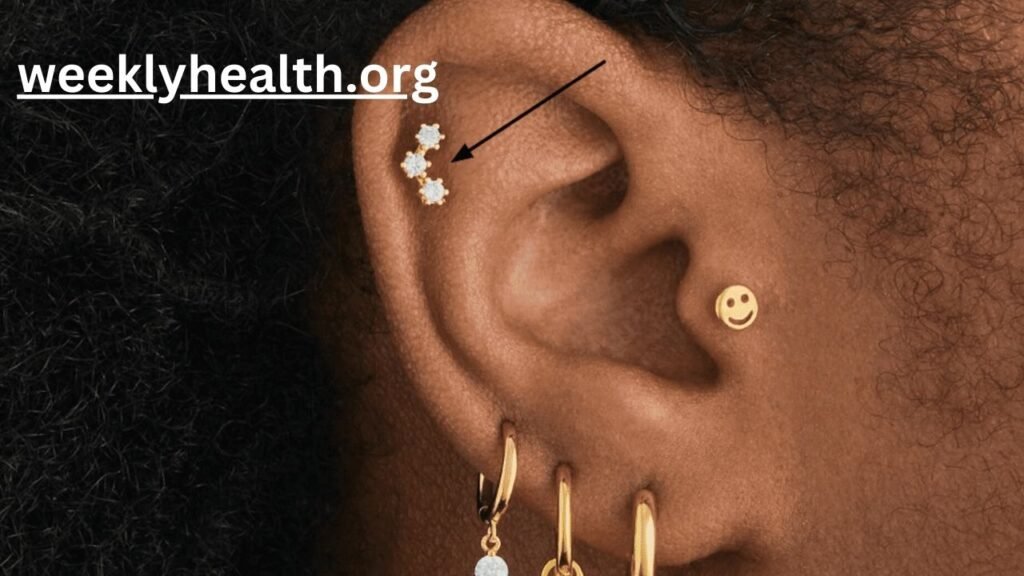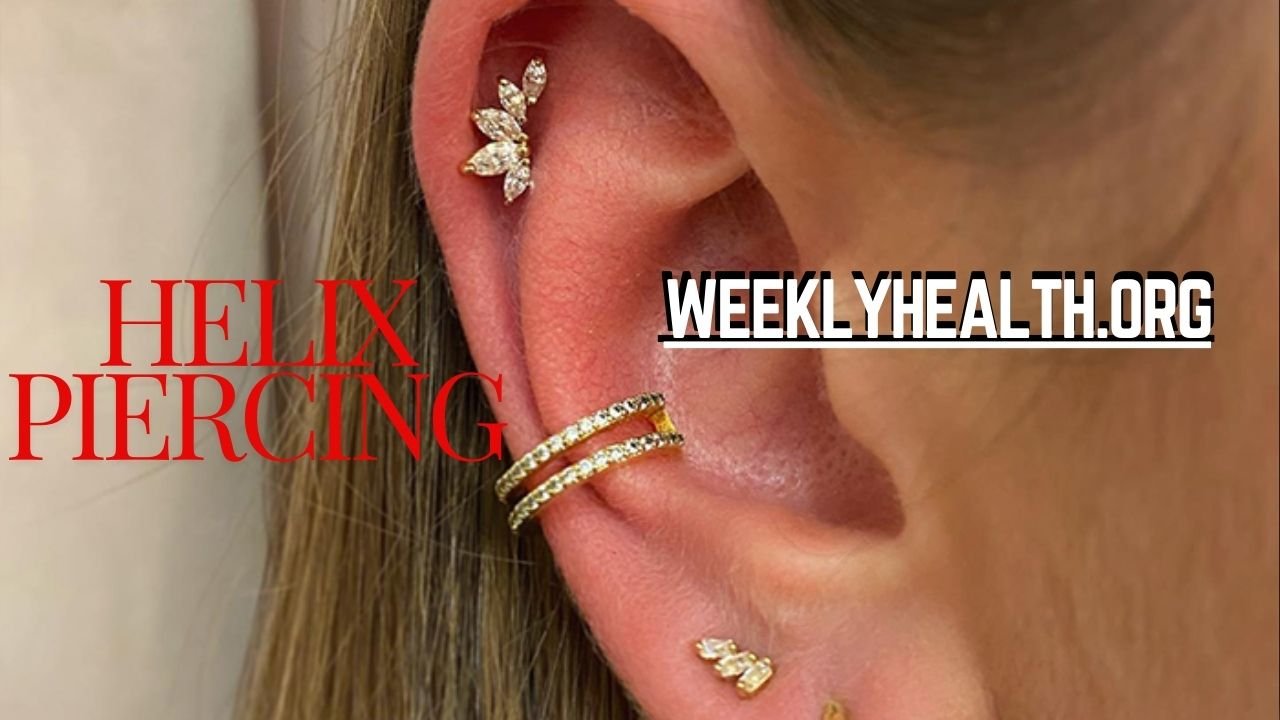Introduction:
Helix piercing is one of the most famous styles of ear piercing, which is characterized with the aid of its location on the better cartilage of the ear. Known for its versatility and aesthetic attraction, helix piercing can be a formidable assertion or a diffused enhancement to an everyday look. This comprehensive manual delves into the many aspects of helix piercings, along with their records, types, technique, aftercare, ability dangers, and style features.
Maintenance of Helix Piercing Jewelry
Maintenance of helix piercing rings is important to maintain their quality appearance and to ensure the fitness of the piercing. Regular cleaning with a gentle cleaner with non-abrasive rings will help prevent dust and oil build-up. Avoid using aggressive chemicals that can damage both the jewelry and the piercing. It’s also important to check the jewelry for any signs of wear or damage, along with loose stones or bent pieces that could irritate the piercing. If damage is found, replace the jewelry immediately to avoid headaches.
Seasonal Thoughts on Helix Piercing
Different seasons can affect the piercing in different ways. In the colder months, sports caps and scarves can cause infection and introduce microorganisms to piercing websites online. During the summer season, exposure to sunlight, sand, and chlorine from swimming pools can increase the risk of contamination. It is very important to protect the piercing from these factors by using sports-breathable, healthy substances and avoiding long-term publicity in harsh conditions. Always clean the piercing after swimming or excessive sweating to avoid infection.
Choosing a professional piercer
Choosing a professional piercer is one of the most important steps in getting a helix piercing. Researching and reading reviews about nearby piercing studios can help you become familiar with authentic specialists. Look for certifications and memberships in professional piercing agencies, which means compliance with industry requirements. During the session, monitor the cleanliness of the studio and ask about sterilization techniques. A professional piercer must be willing to answer any questions and provide specific instructions for aftercare.
Treatment of pain during Helix Piercing
Pain tolerance is different for every man or woman, however, there are approaches to managing pain for the duration of a helix piercing. Applying a numbing cream an hour before the procedure can ease the pain. Deep breathing strategies during piercing can also help manage tension and pain. After a piercing, over-the-counter pain relievers that include ibuprofen can reduce pain or swelling. Avoiding alcohol and caffeine before piercing can reduce bleeding and reduce overall soreness.
Combination of Helix piercings with other piercings
The Helix piercing can be creatively mixed with different ear piercings to create a precise look. Pairing a piercing with a daith or tragus piercing can add intensity and size to the ear’s appearance. For a more dramatic effect, think of an ear constellation where more than one piercing is strategically placed to resemble a star pattern. The key is to ensure that there is enough recovery time between piercings to avoid crowding your ear cartilage and to maintain proper care for each piercing.
The role of Piercing Studios in healing
Piercing studios play an essential role in the recovery process of helix piercings. A legitimate studio will provide comprehensive aftercare instructions and may provide follow-up appointments to reveal the piercing’s progress. They can support specific aftercare products and strategies tailored to individual wishes. In addition, studios often create a supportive environment where clients can ask questions and seek referrals throughout healing, ensuring nice viable piercing results.
Traveling with the new Helix Piercing
Traveling with a new piercing requires special care to maintain proper care. Pack a small aftercare kit with saline, cotton swabs, and any recommended cleaning supplies. Do not touch the piercing with unwashed hands, especially in public places. When cleaning a piercing abroad, be careful of the neighborhood water; using bottled or distilled saline water can prevent infections. Likewise, it is wise to stay away from sports such as swimming in unfamiliar waters, where microorganisms can also harbor.

Influence of Lifestyle on Helix Piercing
An individual’s lifestyle can significantly affect the attainment and eligibility of a helix piercing. Active folks who participate in sports or strenuous sports must keep in mind the potential trauma of piercing. Wearing shielding headgear and warding off touch sports activities until the piercing is healed can prevent complications. In addition, humans with busy lives ought to set reminders to often carry out cleaning exercises and be vigilant to avoid stressors that might negatively affect the restoration process.
Myths and misconceptions about Helix Piercing
There are many myths and misconceptions surrounding helix piercings. One unusual misconception is that cartilage piercings are extraordinarily painful and vulnerable to headaches. While cartilage piercings require cautious aftercare, they’re normally no longer extra painful than other piercing styles. Another false impression is that using alcohol or hydrogen peroxide is useful for cleaning; in fact, those substances can damage the recovery tissue. Understanding the statistics can assist individuals make informed selections and take the right care of their piercings.
Helix Piercing and allergic reactions
Allergic reactions to piercing jewelry are a situation for some individuals. Nickel is an unusual allergen found in many styles of earrings, so it is very important to choose nickel-free materials such as titanium or surgical metal. Symptoms of hypersensitivity consist of redness, itching, and swelling around the piercing site. If you suspect an allergic reaction, put the jewelry away immediately and consult a healthcare professional. Using hypoallergenic rings from authentic sources can save you from these reactions and provide an easy method of recovery.
Helix piercing for different ear shapes
The Helix Piercing can be adjusted to fit numerous ear shapes, enhancing their natural contours and features. For people with smaller ears, a single piercing with a sensitive stud can add diffused beauty without overwhelming the ear. Those with large or extra-designed cartilage can explore multiple piercings, including a double or triple helix arrangement to create an extra distressed look. It is important to see an experienced piercer who can suggest the appropriate placement and fashion of jewelry based on the unique shape and anatomy of the ear.
Timeline and stages of healing
Understanding the timeline and stages of a helix piercing can help manage expectations and ensure proper care. Initially, the piercing may be purple and swollen, this is a daily reaction to the method. This acute recovery segment usually lasts several weeks. The intermediate section includes a slow reduction of swelling and pain, lasting up to 3 months. The final stage is the complete healing of the cartilage, which can take six months to a year. Patience and consistent aftercare during these stages are key to achieving a fully healed and healthy piercing.
Risks and Considerations
While the concept of a DIY helix piercing may seem appealing to some, there are huge dangers involved. Without professional training and sterile equipment, there can be a high risk of contamination, misplacement, and cartilage damage. Professional piercers use specific techniques and equipment to reduce these risks and ensure a safe and successful piercing. Additionally, professional studios offer a sterile environment that cannot be replicated at home. For these reasons, you are very strongly advised to seek out a trained piercer rather than attempting a DIY piercing.
Cultural Variation in Helix Piercing Practices
Helix piercings are accepted in different cultures across the sector, each with its unique practices and meanings. In several cultures, cartilage piercings are performed as part of conventional rituals or as symbols of social prestige and splendor. For example, certain African tribes include intricate ear piercings in their cultural attire. In Western cultures, it has evolved into style statements and forms of personal expression. Understanding these cultural versions adds depth to the appreciation of piercings and their importance in different societies.
Innovation in piercing technology
Advancements in the piercing generation have greatly advanced the safety and luxury of helix piercings. Modern piercing studios often use autoclave sterilizers to ensure that all equipment and jewelry are completely sterile. In addition, the development of amazing, biocompatible materials such as titanium and niobium has reduced the incidence of hypersensitivity reactions and infections. Innovations involving dermal punches and specialized cartilage piercing needles also contributed to extra special and less painful tactics. These technological advances are constantly beautifying the pleasure of piercing and the effects for clients.
The role of diet in piercing treatment
A balanced diet can play a key role in the recovery of the helix-piercing method. Nutrients consisting of nutrition C, zinc, and protein are important for tissue regeneration and immune properties. Consuming ingredients rich in these nutrients, such as citrus climaxes, nuts, seeds, and lean meats, can sell faster and stronger recovery. Staying hydrated is also important because proper hydration helps maintain pores skin elasticity and overall health. Avoiding excess sugar and processed foods can prevent infection and help make the road to recovery smoother.
Helix Piercing and workplace acceptance
The popularity of helix piercings in the workplace varies widely by industry and agency culture. In innovative fields including fashion, music, and artwork, spiral piercings are often accepted or even celebrated as forms of self-expression. However, in a more conservative or corporate environment, piercings may be seen as situations for stricter dress codes. You must understand your workplace’s specific guidelines and remember discreet jewelry alternatives if necessary. Communicating with employers at the level of private expression and professionalism can also help to navigate these situations correctly.
Psychological benefits of Helix piercing
In addition to their aesthetic appeal, spiral piercings can provide mental benefits to the people who choose them. For many, piercing can be an act of regaining control over the body and expressing one’s individuality. This can cause accelerated self-confidence and self-esteem. The piercing ritual, along with anticipation, selection, and aftercare, can also serve as a form of self-care and empowerment. In addition, the presence of a unique and significant piercing can act as a daily reminder of personal milestones, achievements, or full-size lifestyle modifications.
Conclusion:
Helix piercing is a universal and fashionable asset for those who want to express their individuality through a framed drawing. With their rich records, variety of styles, and cultural significance, they offer a unique way to enhance personal aesthetics. Proper care, knowledge of the recovery system, and choosing the right earrings are critical to a successful piercing. Whether chosen for its aesthetic appeal or private meaning, spiral piercings remain a celebrated and timeless choice in the international field of body adornment.

FAQs:
1. How painful is Helix Piercing?
The pain level of a helix piercing can vary depending on the pain tolerance of a man or woman. It is generally described as a short, sharp sting that quickly subsides after the needle passes through the cartilage. While some soreness and throbbing can be expected at some point in the initial recovery phase, many people find this to be manageable with proper care and pain management.
2. How long does a Helix Piercing take to heal?
A helix piercing usually takes 6 months to a year to heal completely. Initial recovery, where the piercing becomes less tender and the swelling decreases, usually occurs within a few weeks to a few months. However, the cartilage takes longer to heal completely and requires constant follow-up care to save you headaches.
3. Can I sleep on my Helix Piercing?
It’s really helpful to avoid sleeping on your side with a brand-new helix piercing to prevent infection and stress that can hinder healing. Using a travel pillow or pillow with an indentation in the center can help protect the piercing during storage. Once the piercing is fully healed, it becomes less sensitive and should be extra comfortable to rest on.
4. What should I avoid during the healing process?
During the recovery process, it is very important not to touch the piercing with unclean hands, as this can introduce microorganisms and cause contamination. When cleaning, do not use alcohol, hydrogen peroxide, or various aggressive chemicals, as they can damage the tissue of the filling. Avoid swimming in swimming pools, hot tubs, and herbal bodies of water, as these are capable of harboring microorganisms that can infect the piercing. Also, be careful with sports that can cause trauma or catch jewelry.
Read More: Ilikecix



